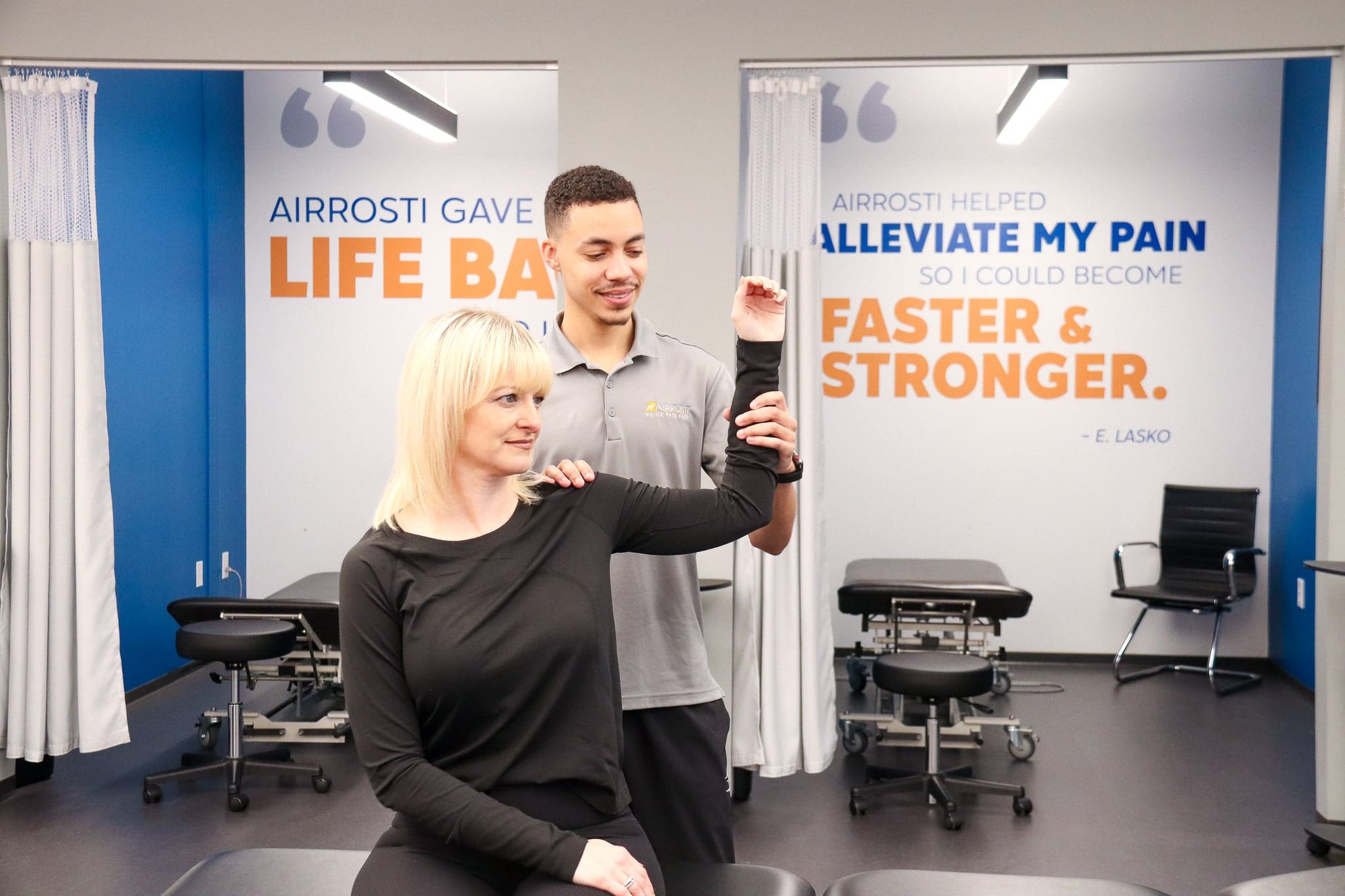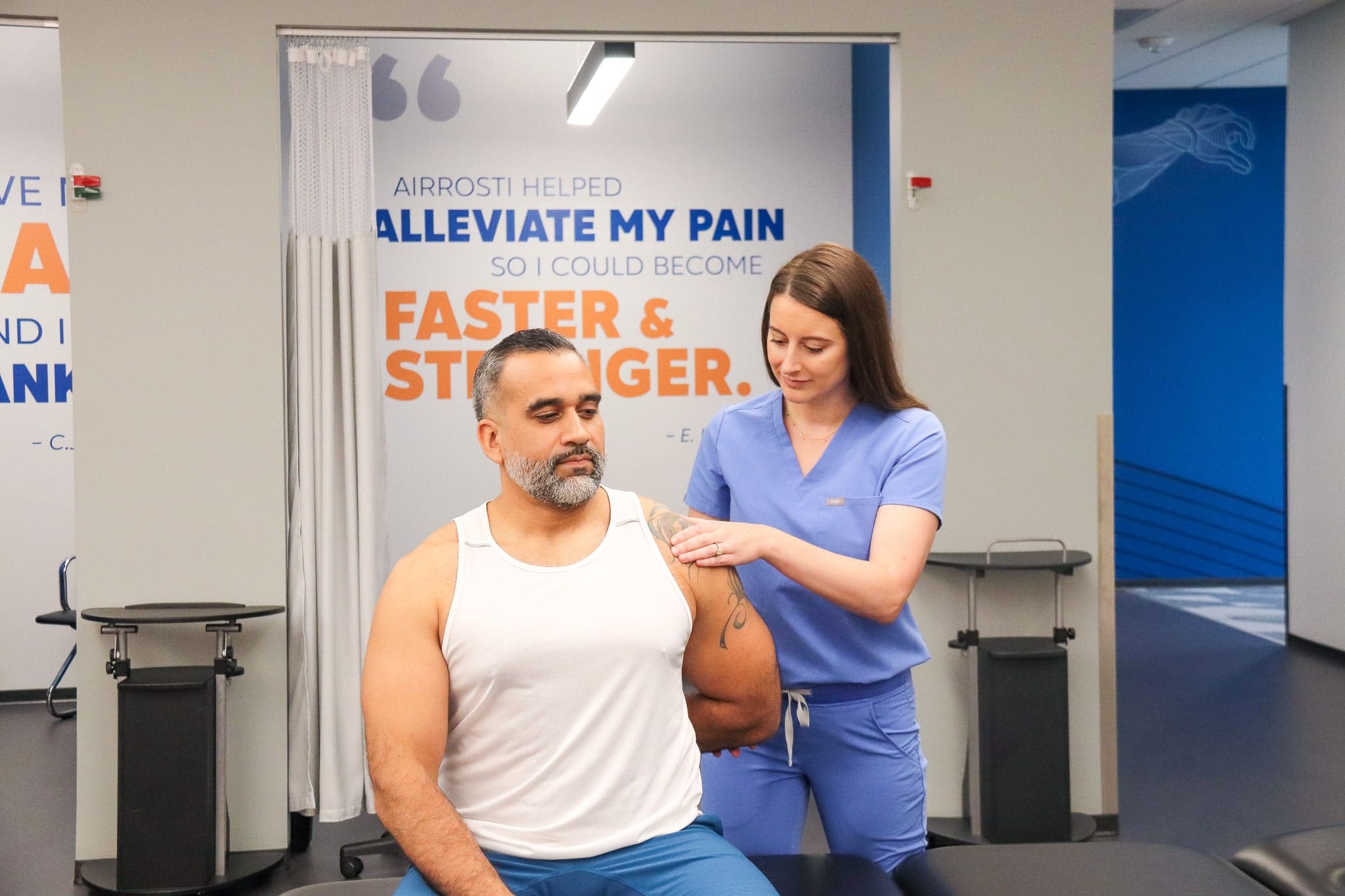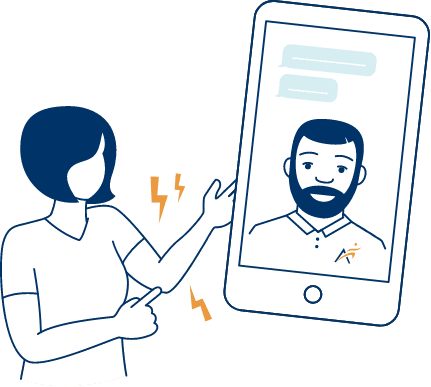(21,000+ reviews on Google across 150+ locations)

Have questions or would like to schedule over the phone? Call us at 844-719-5079
Find an Airrosti Clinic Near You (OH, TX, VA, WA)
We take the time needed for a thorough examination to find the underlying cause of your pain.
Airrosti Providers use hands-on manual therapy to treat rotator cuff symptoms to reduce pain, increase mobility, and accelerate healing.
No surgery, injections, or prescription medication.
Patients have shorter recovery time with an average of 3.2 visits over 2 weeks.
Speed your recovery and keep your pain from returning.


The rotator cuff is a key component of the shoulder joint, responsible for the movement of your arm overhead. Because the rotator cuff is a group of muscles, it is very susceptible to overuse injuries.
The shoulder joint’s movement and stability are supported by a group of four muscles comprising the rotator cuff. Most rotator cuff disorders are caused by a combination of normal wear and tear and overuse. Over time, your rotator cuff muscles can become damaged or weak from regular use or activity.
Injuries can vary in severity, ranging from a minor muscle or tendon strain that typically heals without permanent damage to a partial or complete muscle tear that may necessitate surgical repair. Impingement can occur when tendons rub against bone due to regular use or excessive strain. This friction damages and irritates the tendons, leading to inflammation.
You’ll also learn about traditional treatment options and how Airrosti can help relieve rotator cuff pain.
Still have questions or concerns about your rotator cuff pain? Schedule a no-cost video chat with one of our Providers.
As you get older, your rotator cuff muscles can fray or thin from everyday activities. Furthermore, engaging in physical tasks with frequent raising of the arms (such as playing tennis, swimming, throwing, lifting, or even painting) can contribute to developing rotator cuff issues. Thus, you may sometimes hear this condition called Tennis Shoulder, Swimmer’s Shoulder, or Pitcher’s Shoulder.
The symptoms of a rotator cuff injury result from the inflammation associated with the strain, which can lead to swelling, pain, and reduced range of motion. Most often, rotator cuff pain can occur on the front and sides of your upper arms or shoulders.
The pain associated with a rotator cuff injury may feel like:
• A dull ache deep in the shoulder
• Pain that radiates down the affected arm
• Arm weakness
These symptoms can cause a limited range of motion while performing overhead activities or lifting arms, as well as disturb your sleep especially if lying on the affected shoulder. Additionally, you may feel crackling or hear popping if a rotator cuff tear is present. However, rotator cuff tear symptoms vary case by case and should best be discussed with a healthcare professional.
Not all shoulder pain stems from the shoulder itself and may sometimes be symptomatic of a more serious problem. The pain caused by a rotator cuff injury becomes more severe when the shoulder is moved. If shoulder pain is present without apparent cause, you should promptly seek medical attention. Should there be any concern that the pain is coming from the heart, seek emergency medical care.
Surgery is not always necessary for a rotator cuff injury. In many cases, conservative treatments such as rest, physical therapy, Airrosti care, medication, and targeted exercises can effectively manage symptoms and promote healing. Surgery may be considered if conservative treatments fail to provide relief, or if there is significant damage to the rotator cuff that requires surgical repair. It’s important to discuss all treatment options with a healthcare professional to determine the best course of action.
It’s generally safe to take medications for rotator cuff pain, but it’s important to use them as directed by your healthcare provider. Over-the-counter pain relievers such as acetaminophen or nonsteroidal anti-inflammatory drugs (NSAIDs) can help reduce inflammation and alleviate discomfort. Prescription medications such as muscle relaxants or corticosteroid injections may be recommended for more severe cases of rotator cuff pain. It’s important to consult with a healthcare professional before starting any new medication regimen, especially if you have underlying health conditions or are taking other medications.
Yes, there are several self-care techniques and exercises that can help alleviate rotator cuff pain. These may include gentle stretching exercises to improve flexibility, strengthening exercises to stabilize the shoulder joint, and targeted exercises to strengthen the rotator cuff muscles. Additionally, applying ice or heat to the affected area, and avoiding activities that exacerbate symptoms can help promote healing and prevent further injury.
While it’s important to avoid activities that exacerbate rotator cuff symptoms, completely restricting all activity may not be necessary. Modifying activities to reduce strain on the shoulder joint and incorporating rest breaks can help alleviate symptoms. Low-impact exercises such as swimming or cycling can be beneficial for maintaining mobility and promoting healing without putting excessive strain on the shoulder. However, if shoulder pain persists or worsens with activity, it’s important to consult with a healthcare professional for proper evaluation and guidance on activity modification.
I work hard for a living. One day I threw a tiny little branch out of the goat pen and my shoulder twinged and shot on fire. Dr. Barnes began therapy for a rotator cuff tear or partial tear. Within 3 visits the pain was subsiding and I was getting range of motion back. I was concerned because of how much motion I had lost in that arm. Certain positions would light up a fire in the shoulder and I couldn't hold it. My hard work ability had greatly diminished. It did take work. So, I had to do exercises and stretches when not in clinic for treatment, but I wanted that motion back so I did them. One of the treatments was to toss a ball against a wall or to someone and my wife really liked that one because we got to play catch. My range of mo...+ show moretion is back and the pain is WAY managed, hardly noticeable, if at all. I will take any future joint injury to Dr. Barnes and his very helpful therapist, Toni.
by Mike Singleton
We offer both in-clinic and telehealth appointments to best suit your needs.
Reviewed by Casey Crisp, Doctor of Chiropractic
Disclaimer: Always consult with your doctor before starting any exercise program. If you experience any numbness, tingling or reproduction of your symptoms, please contact your doctor.
